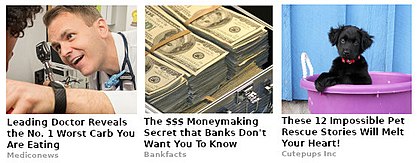
Back طعم النقرة Arabic Klikbeyt Azerbaijani Clickbait BAR Кликбейт Bulgarian Clickbait BS Pescaclics Catalan Clickbait CEB کلیک بەیت CKB Clickbait Czech Clickbait Danish

Clickbait (also known as link bait[2]) is a text or a thumbnail link that is designed to attract attention and to entice users to follow ("click") that link and read, view, or listen to the linked piece of online content, being typically deceptive, sensationalized, or otherwise misleading.[3][4][5] A "teaser" aims to exploit the "curiosity gap", providing just enough information to make readers of news websites curious, but not enough to satisfy their curiosity without clicking through to the linked content. Clickbait headlines often add an element of dishonesty, using enticements that do not accurately reflect the content being delivered.[6][7][8] The "-bait" suffix makes an analogy with fishing, where a hook is disguised by an enticement (bait), presenting the impression to the fish that it is a desirable thing to swallow.[9]
Before the Internet, a marketing practice known as bait-and-switch used similar dishonest methods to hook customers. In extreme degree, like bait-and-switch, clickbait is a form of fraud. (Click fraud, however, is a separate form of online misrepresentation which uses a more extreme disconnect between what is being presented in the frontside of the link versus what is on the click-through side of the link, also encompassing malicious code.) The term clickbait does not encompass all cases where the user arrives at a destination that is not anticipated from the link that is clicked.
- ^ Gardiner, Bryan (18 December 2015). "You'll Be Outraged At How Easy It Was To Get You To Click On This Headline". Wired. Retrieved 2 August 2018.
- ^ Brown, Sunni (2014). The Doodle Revolution: Unlock the Power to Think Differently.
Link bait is content or a feature on a website that is expressly designed to get users' attention so they click through to another website.
- ^ Frampton, Ben (14 September 2015). "Clickbait - the changing face of online journalism". BBC. Retrieved 12 June 2018.
Headline writing has long been considered a skill but, in the digital age, a new word has become synonymous with online journalism - clickbait.
Put simply, it is a headline which tempts the reader to click on the link to the story. But the name is used pejoratively to describe headlines which are sensationalised, turn out to be adverts or are simply misleading. - ^ O'Donovan, Caroline. "What is clickbait?". Nieman Foundation for Journalism. Niewman labs. Retrieved 12 June 2018.
Clickbait is in the eye of the beholder, but Facebook defines it as 'when a publisher posts a link with a headline that encourages people to click to see more, without telling them much information about what they will see.'
- ^ Zheng, Hai-Tao; Chen, Jin-Yuan; Yao, Xin; Sangaiah, Arun; Jiang, Yong; Zhao, Cong-Zhi (1 May 2018). "Clickbait Convolutional Neural Network". Symmetry. 10 (5): 138. Bibcode:2018Symm...10..138Z. doi:10.3390/sym10050138. ISSN 2073-8994.
- ^ Derek Thompson (14 November 2013). "Upworthy: I Thought This Website Was Crazy, but What Happened Next Changed Everything". The Atlantic.
- ^ Katy Waldman (23 May 2014). "Mind the 'curiosity gap': How can Upworthy be 'noble' and right when its clickbait headlines feel so wrong?". National Post.
- ^ Emily Shire (14 July 2014). "Saving Us From Ourselves: The Anti-Clickbait Movement". The Daily Beast.
- ^ "Where Clickbait Came From, And Why It's Here to Stay". www.naytev.com. Retrieved 21 December 2021.
© MMXXIII Rich X Search. We shall prevail. All rights reserved. Rich X Search